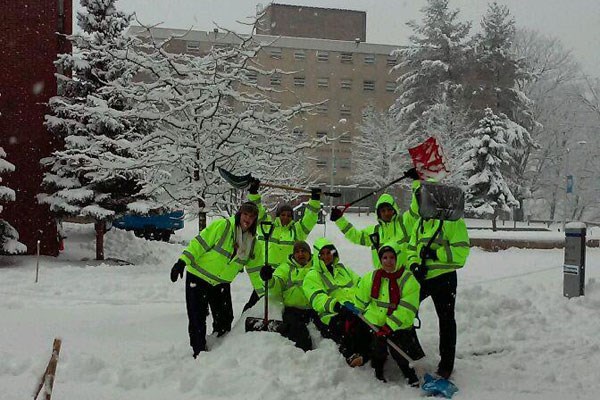Storm After Storm, Facilities Operations and Services Keeps Campus Moving

02/20/2015
By Ed Brennen
Mother Nature’s relentless flurry of punches over the past month has set snowfall records, wreaked havoc with class schedules and left even the heartiest of New Englanders saying, “No más!”
For Facilities Operations and Services, the department responsible for clearing the streets, parking lots, sidewalks and steps across the university’s 150-acre campus, the unprecedented series of blizzards and winter storms has not only tested ice melt and salt budgets, but also physical and mental stamina.
“All the storms have started to blur together to be honest with you,” says Joseph LoBuono, Associate Director of Operations and Services. “It’s off the charts. It’s been crazy.”
As LoBuono described his department’s operations recently, the seven-member grounds team was preparing for Winter Storm Neptune, which delivered another 16 inches of fresh powder Valentine's weekend. According to the UMass Lowell Weather Center, the city’s snowfall total through Feb. 18 was 103.2 inches.
That number is even more impressive when you consider the city saw just a trace of snow through December and most of January. But Operations and Services, which relies on two separate weather forecasting companies to prepare for storms, knew a big change was on the horizon.
“That jet stream switched and they both said it was basically going to be one storm after another storm after another storm,” LoBuono says. “They gave us a good idea it was going to happen, but nothing like this.”
The game plan
With each impending storm, LoBuono looks at the weather reports with Director of Operations and Services TJ McCarthy. They then formulate a snow-clearing game plan with Grounds Operations Manager Sean Belanger and Housekeeping/Building Services Manager Gualter Almeida, whose 46-member team is not only responsible for shoveling all stairways and a 5-foot clearance at the base, but also cleaning up salt and snow that’s tracked into buildings.
If a storm is expected to roll in at midnight, LoBuono says staff members start operations around 2 a.m. Then, at 4 a.m., LoBuono and McCarthy hold a conference with several other university officials to give a status update and determine if classes need to be canceled.
“The goal is always to get classes open — people are here to learn -- but the more we can get people off campus, the easier it is to clean,” says LoBuono, who estimates it takes six hours to completely plow and salt the campus’ 6.5 miles of walkways and 2.2 million square feet of parking lots once the last snowflake has fallen in an average storm.
While the grounds team is responsible for parking lots and walkways on East Campus, two separate outside contractors are hired to clear snow on North and South campuses. The contractors have also been busy clearing several roofs. “The campus is too big for just our grounds department to do,” LoBuono says.
As for the machinery needed to move all that snow, the university has a fleet of five pickup trucks equipped with plows, two Toolcats and one loader truck. The contractors bring in additional equipment, which for most storms includes 10 Bobcats, seven tri-axle dump trucks, 10 plowing pickups and four loaders. Check out our "by the numbers" graphic on this season's snow.
LoBuono says the department has gone through 10 pallets of ice melt (or about 25,000 pounds) and seven loads of salt (enough to fill a tractor trailer) — and spring is still a month away.
Haul of a job
Being an urban campus, the biggest challenge is finding a place to put all the snow.
“We try to stack as much as we can in the parking lots, but parking is at such a premium that a lot of it needs to be hauled out now,” says LoBuono, who notes that 21 trucks hauled snow for 25 straight hours to snow dumps on North and South campuses during a recent storm.
Another big challenge is the marathon shifts required to get through the storms. While managers may be on the job for 36 hours straight, driving around campus to direct the operation, LoBuono knows that’s nothing compared to the staff members who are out in the elements shoveling around the clock.
“I can’t say enough about our staff. It’s impressive how long they work and how much they care about the campus to make sure it’s open and ready,” LoBuono says. “Some of them even slept here during the blizzard. They grabbed a couch in O’Leary Library and rested for four hours and went back out and shoveled again.”
For Belanger, who joined Operations and Services in January, the past month has been a baptism by blizzard.
“The staff has been joking that I have brought the snow since my hiring,” says Belanger, a native New Englander who was in elementary school during the Blizzard of ’78. “I’ve kind of viewed this past month’s snow as a positive. It’s shown me how quickly the ops team can respond to the demands of a fast-moving campus.”
LoBuono, also a native New Englander, is staying positive, as well. But he’s already thinking ahead to the work that will need to be done once the mountains of snow finally disappear.
“There’s going to be a lot of grounds cleanup afterward, a lot of bushes and shrubs that are going to be damaged,” LoBuono says. “I joked the other day, this is going to be the first time we’ve been asked to move a snow pile for graduation in May.”
